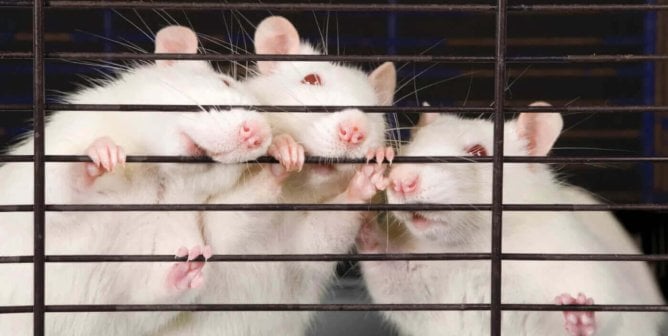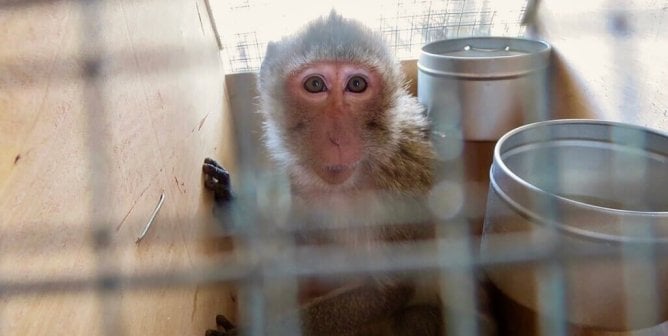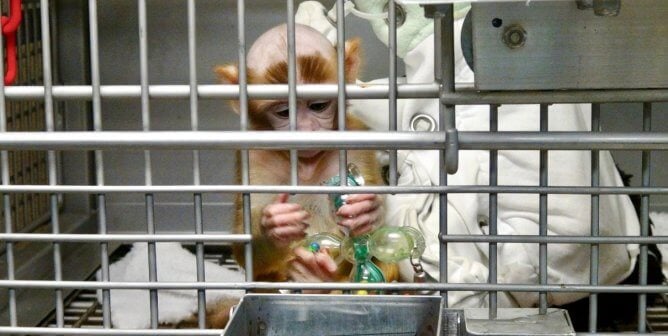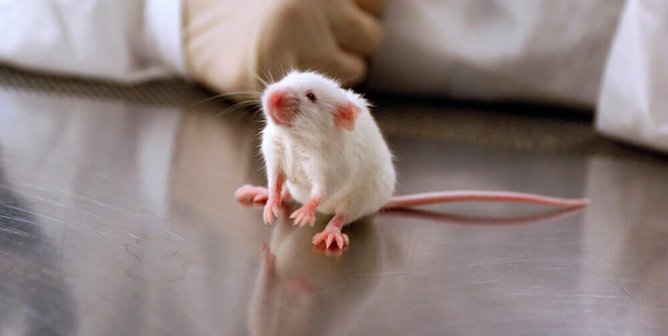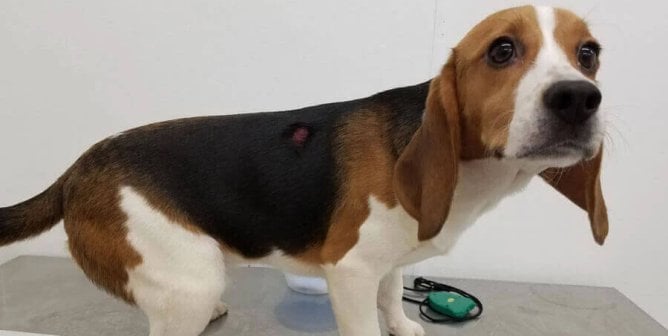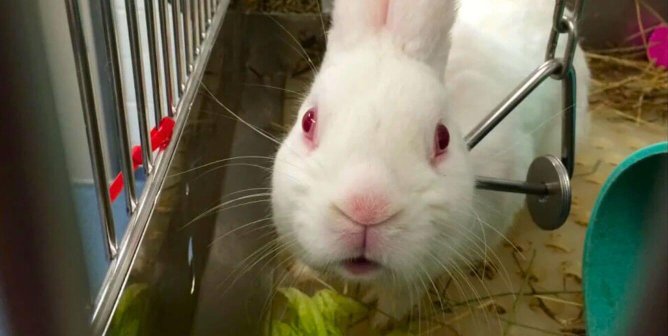Animal Experiments at Eastern Virginia Medical School Exposed
What happens to animals used in taxpayer-funded experiments at Eastern Virginia Medical School (EVMS) in Norfolk, Virginia? PETA has uncovered shocking welfare violations and other horrors at the school.
- Official Animal Welfare Concerns
- Number of Animals Used
- Media Coverage
- Examples of Animal Experiments
- Public Funding
Official Animal Welfare Concerns at EVMS
Every year, EVMS uses an untold number of animals—including primates, rabbits, chinchillas, and pigs, mice, and rats—in experiments.
While other universities in Virginia have publicly pledged a commitment to the principles of the “3Rs”—Replacement of animal-based models with innovative technology, Reduction in the number of animals used in experiments, and Refinement of scientific methods to minimize pain and suffering—EVMS makes no mention of such a commitment on its website.
Federal oversight agencies tasked with ensuring compliance with laws and regulations have documented the following at EVMS:
May 2, 2023, U.S. Department of Agriculture (USDA) Animal and Plant Health Inspection Service (APHIS) inspection report—one repeat violation
- Significant changes were enacted in a protocol without Institutional Animal Care and Use Committee (IACUC) review and approval. The protocol described blood sampling for all baboons in pregnancy studies as being performed at two- to four-day intervals and stated that animals would be weighed monthly (then later stated weekly). A 17-year-old baboon underwent daily blood draws during multiple time periods, and the weights of five baboons were documented only during their semi-annual physicals, TB tests, or surgical procedures. The protocol also described an anticipated adverse event (seizures) in approximately 10% of animals receiving a drug in the study while pregnant and documented steps for handling nonresponsive, seizing, or unconscious animals, including performing bloodwork, catheter placement, and supplementation for low blood glucose levels. A 16-year-old baboon was found unresponsive while receiving the drug in the study but wasn’t provided with the outlined treatment.
January 12, 2023, APHIS inspection report—two critical violations
- CRITICAL: Significant changes were enacted in two protocols without IACUC review and approval or proper documentation. In one protocol, four chinchillas continued to be used for a study despite reaching and passing their “humane endpoints” (defined as the earliest point in an experiment when an animal’s physical pain or psychological anguish may be stopped by the experimenter without compromising the experiment). After losing up to 30% of their bodyweight, three chinchillas were killed and the fourth died. A necropsy found that she suffered “cardiovascular failure secondary to severe constipation.” In addition, the chinchillas were kept on the protocol far longer than allowed—for 21 months in an experiment that was approved to run for only 22 weeks. In the second protocol, several items (e.g., the age and weight of animals used) were changed without prior IACUC approval.
- CRITICAL: After a procedure in which intravenous insulin was administered, 11 rhesus macaques experienced severely low blood sugar and prolonged anesthesia recovery times, some over five hours. The macaques were deprived of medical interventions despite blood glucose levels so low that they were undetectable with a handheld glucometer. One rhesus macaque remained unconscious or semiconscious for over four hours, during which time he received no medical care or monitoring of his blood glucose level despite being hypoglycemic at the end of the 30-minute study. He was deprived of medical care for more than seven hours despite being barely responsive and paralyzed. He was later killed.
- A USDA official notified OLAW of the above federal Animal Welfare Act (AWA) violation pertaining to the pregnant baboons. The USDA official who notified OLAW of the related AWA violation noted that despite requests to EVMS for more information, it remained unclear why up to six cesarean sections (per animal) were scientifically justified. The official stated that “the study in question raises concerns about animal health and well-being.”
September 14, 2021, APHIS inspection report—two critical violations resulting in a USDA official warning
- CRITICAL: Three baboons had undergone multiple major operative procedures—three cesarean surgeries each—without prior approval. These experiments on pregnant baboons have been ongoing since the mid-1980s, and some baboons have been subjected to up to six successive C-sections each during the experiments. According to Public Health Services documents, three fetuses have been killed at delivery and one was stillborn.
- CRITICAL: A chinchilla caught her toe in a plastic hut in her enclosure, causing her to lose part of the digit.
August 13, 2020, self-reported NIH OLAW report (1I)
- For several days, workers failed to inspect the watering device in a cage confining three mice to confirm that it was functioning properly. Two of the mice were found dead, and the third mouse appeared dehydrated. It was determined that workers failed to uncover the watering device, leaving the mice without access to water.
February 13, 2020, self-reported NIH OLAW report (1H)
- Eight weanling mice were found dead after a worker failed to ensure that the animals had access to food after taking them from their mother. The worker left two mice in a cage with no food, and the other six were too small to eat from the food dispenser. The surviving mice were found to be extremely lethargic. The worker had been directly involved with several previous incidents concerning mouse colony management, and the IACUC later determined that the staffer “had a history of incompetence in mouse breeding and colony management.”
August 11, 2015, APHIS Inspection Report
- In the facility’s 2014 annual report, the total number of animals listed was inconsistent with prior USDA records as well as with facility acquisition records.
March 11, 2014, U.S. Department of Agriculture (USDA) Animal and Plant Health Inspection Service (APHIS) inspection report—one violation
- An animal of unidentified species died “due to self-inflicted injury by an enrichment device. Enrichment options provided to animals must be non-injurious.
Examples of Animal Experiments at EVMS
The following experiments were recently conducted at EVMS, and most of them were publicly funded:
Effect of antagonism of the NMDA-receptor by intravenous low-dose ketamine on obsessive-compulsive behavior in the nonhuman primate
Experimenters administered IV ketamine to three baboons and one macaque. The primates had been exhibiting self-harming behavior indicative of depression and mental deterioration, including pacing, excessive grooming, aggression, and repetitive circling movements. This behavior was the result of the animals being kept perpetually confined to cages in a laboratory, denied normal socialization, and used in experiments. Some of them had been at the EVMS lab for over 15 years. (PETA learned that videos of this experiment existed and obtained the disturbing footage after filing a public records request.)
Estrogen promotes microvascularization in the fetus and thus vascular function and insulin sensitivity in offspring
Experimenters injected some pregnant baboons with letrozole—a drug that reduces estrogen levels in the body. Other pregnant baboons were given a hormone that increases estrogen levels. The fetuses of some of the baboons were surgically removed and used for tissue analysis. Other baboons were allowed to continue their pregnancies and give birth to their infants.* The experimenters compared how blood microvessels grew in the two groups of baboons.
*According to an investigation published by Lady Freethinker, documents from EVMS indicate that some baboons given letrozole suffered spontaneous abortions or seizures and that researchers found them comatose in their cages.
A follow-up article, also published by Lady Freethinker, contained the findings of a public records request that showed one baboon, Jemma, has a long history of self-mutilation brought on by the stress of captivity, confinement and being used for experiments for the past 12 years. According to the documents, Jemma was subjected to three cesarean section surgeries over three consecutive years (2019, 2020, and 2021) after being diagnosed with cardiomyopathy (a heart muscle disease).
Entries made by lab workers describe “self-trauma,” “overgrooming,” “scabbed ulcers on rump,” and an incident where she “rubbed off the top [layer] of skin” on her forearm. Jemma has suffered from an oral abscess and broken teeth, both “evidence of biting cage bars.” She has sustained hand injuries resulting in partial amputations of two fingers, an exposed nerve, missing digits on two other fingers and one toe, and numerous sedations to close her wounds with sutures or glue.
The only time Jemma did not exhibit self-harming behavior was in 2017 when she was allowed to keep and raise a son, named Boo. During that time, one experimenter wrote she exhibited “very good maternal behavior.” After Boo was weaned at 8 months old and taken away from her, Jemma resumed harming herself within three months, with the first entry simply noting “SIB (self-injurious behavior), trichotillomania (compulsively pulling out her own hair), finger abscess.”
Controllable and uncontrollable stress differentially impact fear-conditioned alterations in sleep and neuroimmune signaling in mice
Experimenters implanted a telemetry device—designed to monitor physiological parameters such as body temperature and brain activity—in the abdomens of mice. The mice were then subjected to “escapable and inescapable stresses”—including frequent painful shocks to their feet. The animals’ brain activity was monitored through their sleep following the shock protocols before they were killed.
Sleep disturbance alters cocaine-induced locomotor activity: involvement of striatal neuroimmune and dopamine signaling
Experimenters disrupted the sleep of mice daily using tactile stimulation via an automated sweeper arm. After two weeks of sleep disruption, the mice were injected with cocaine daily for one week and their movements were observed in various tests. Experimenters determined that sleep fragmentation blunted cocaine-induced hyperlocomotion. They later withheld cocaine from some of the mice and observed their movements during the withdrawal period. At the end of the experiments, the mice were killed and their brains were removed and examined.
Group II metabotropic glutamate receptor activation in the basolateral amygdala mediates individual differences in stress-induced changes in rapid eye movement sleep
Experimenters implanted electrodes in the brains of rats and attached a cable to a plug on their heads to record their sleep. They also implanted a tube in a rat’s brain and injected LY379268, a drug targeting specific receptors in the brain, through the tube. Experimenters then conducted “fear conditioning” tests on the rats, placing them in a chamber and repeatedly subjecting them to painful shocks to their feet. Six days later, the rats were placed back in the chamber but not subjected to shocks—and the experimenters recorded the rats’ sleep to test for the effects of fear memory recall. The rats were then killed.
Biomanufacturing organized collagen-based microfibers as a Tissue ENgineered Device (TEND) for tendon regeneration
Experimenters exposed the Achilles tendon of rabbits by cutting into the skin and two layers of tissue beneath it. They cut incisions into the tendon between the heel bone and the calf muscle and implanted engineered grafts in the area—keeping the grafts implanted for four to 52 weeks. The rabbits were then killed.
Number of Animals Used at EVMS
EVMS submits an approximate number of all animals used in experiments to the Association for Assessment and Accreditation of Laboratory Animal Care (AAALAC) International annually in order to maintain accreditation. This number includes commonly used species not covered by the federal Animal Welfare Act (AWA), such as amphibians, reptiles, fish, invertebrates (including crustaceans and insects), birds, rats of the genus Rattus, and mice of the genus Mus, who are “bred for use in research.” According to EVMS’ AAALAC annual report for 2022, species not covered by the AWA—in this case, mice and rats—accounted for 95.7% of the animals used at EVMS.
| Type of Animal | Number Used |
| Chinchillas | 30 |
| Mice | 1,790 |
| Primates (Old World) | 46 |
| Rabbits | 25 |
| Rats | 459 |
| Total | 2,350 |
Media Coverage
- August 20, 2014: “Group wants investigation of baboon’s strangulation,” The Virginian-Pilot
- May 6, 2022: “Medical School Cited by Feds for Repeatedly Cutting Open Pregnant Baboons,” Lady Freethinker
- September 20, 2022: “National Animal Rights Group Petitions EVMS to End Testing on Baboons,” The Virginian-Pilot
- March 16, 2023: “PETA Urges NIH to Turn Off ‘Money Spigot’ to Virginia Medical School,” The Center Square
- March 17, 2023: “EVMS Found to Have Made ‘Critical’ Violations in Animal Testing Research,” The Virginian-Pilot
- June 12, 2023: “Amid ODU, EVMS and other university citations, Virginia senators call for more animal testing accountability,” The Virginian-Pilot
- October 24, 2023: “LFT Investigates: Mother Baboon Jemma Has Been Self-Mutilating For Years,” Lady Freethinker
- November 8, 2023: “LFT Investigates: Jemma’s Baby Baboon Suffered In Experiments, Too,” Lady Freethinker
- February 8, 2024: “Bipartisan bill on animal testing transparency is downgraded to study after industry pushback,” The Virginian-Pilot
- March 14, 2024: “Animal welfare officials halted repeat C-sections on baboons at Eastern Virginia Medical School,” Virginia Mercury
- April 20, 2024: “Legislature acts to boost animal-testing transparency,” The Virginian-Pilot
- May 12, 2024: “PETA files complaint against EVMS, citing abuse in baboon research,” The Virginian-Pilot
- June 5, 2024: “Virginia legislators express concern over medical school’s treatment of baboons,” Courthouse News
Public Funding for Experiments on Animals at EVMS
In 2023, the Commonwealth of Virginia and its localities gave public universities more than $166 million for animal and non-animal research. Currently, no information is available indicating how much money is spent on animal experimentation in Virginia. The table below shows total annual research funds received by EVMS for the past eight years, including public funding.
In 2023, EVMS spent $5,607 of its funding on Association for Assessment and Accreditation of Laboratory Animal Care accreditation fees.
| Year | State/Local Govt. | Federal Govt. | All Sources |
| 2014 | $222,000 | $28,532,000 | $43,917,000 |
| 2015 | $787,000 | $28,637,000 | $42,269,000 |
| 2016 | $677,000 | $21,459,000 | $32,550,000 |
| 2017 | $626,000 | $21,209,000 | $28,671,000 |
| 2018 | $555,000 | $21,356,000 | $30,010,000 |
| 2019 | $458,000 | $19,408,000 | $27,064,000 |
| 2020 | $267,000 | $15,748,000 | $20,870,000 |
| 2021 | $176,000 | $14,774,000 | $19,415,000 |
| 2022 | $1,186,000 | $17,616,000 | $22,165,000 |
| 2023 | $329,000 | $17,947,000 | $23,991,000 |
Source: Higher Education Research and Development Survey, Table 83 for FY 2014, Table 82 for FY 2015, and Table 5 for FY 2016–2023

